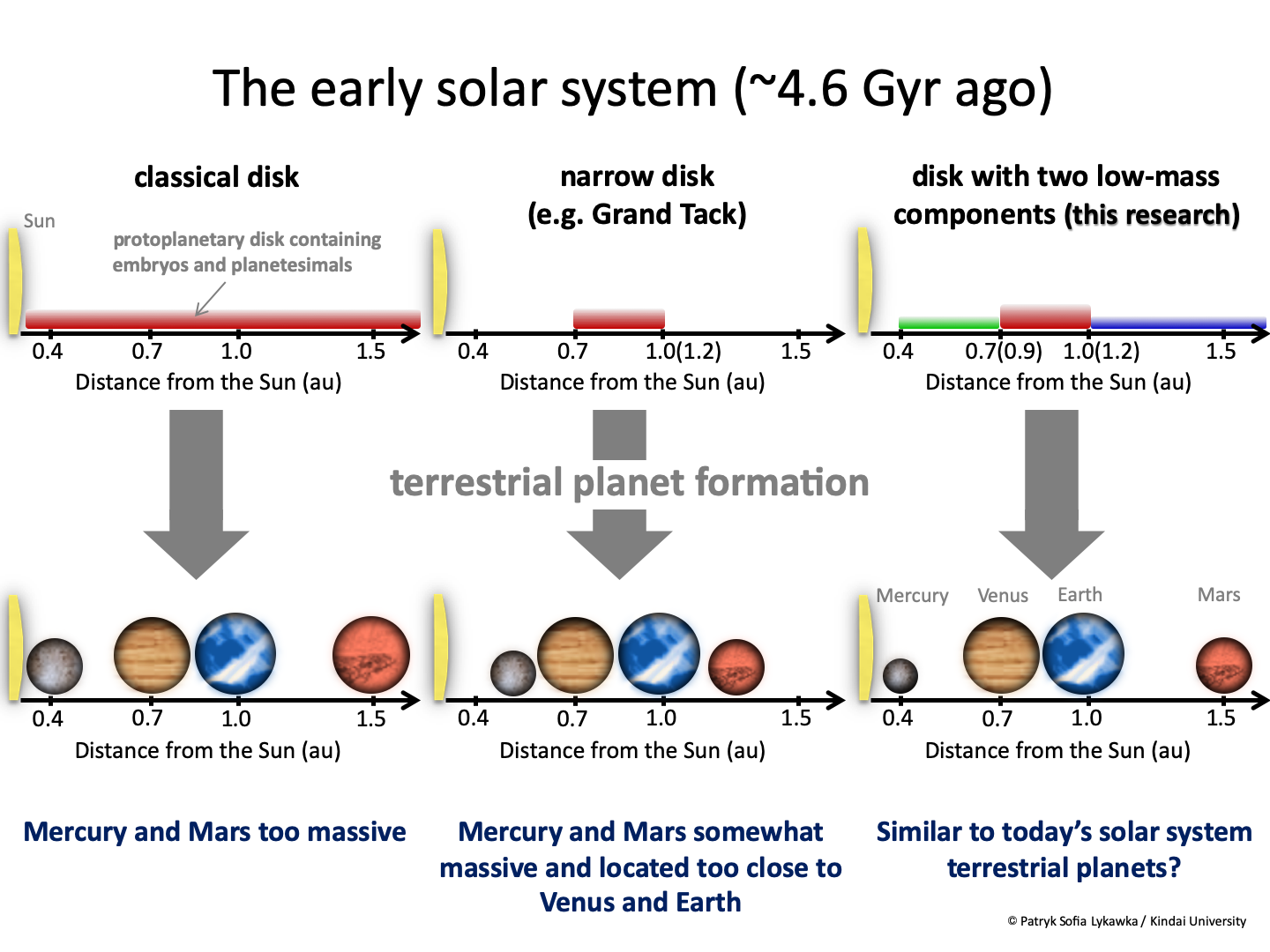Japanese version
Supplementary information about "Constraining the Formation of the Four Terrestrial Planets in the Solar System"
The paper
Official release, webpage, and announcement
About this webpage
The major conclusions and implications of the paper above were publicly announced through a news release from Kindai University and a news note from CfCA/NAOJ.
Here, we further discuss the results of our paper aiming to provide complementary information to the official news issued by Kindai University and CfCA/NAOJ.
The core of this research in a glance
The following schematic figure summarizes the methods and major conclusions in our paper. It illustrates how the different protoplanetary disks considered during the early solar system end up with distinct terrestrial planetary systems after 400 Myr of evolution.
 Click the image to enlarge
Click the image to enlarge
Figure.
Left Panels:
In classical disks,
the mass distribution is represented by a surface density following a single power law across the entire disk (i.e., without drastic changes in the terrestrial planetary region)
Middle Panels:
The high disk mass concentration in a single narrow disk represents the typical outcome of modern protoplanetary disk models (such as the so-called "Grand Tack" model). The surface density is nearly the same across the disk.
Right Panels:
A disk with mass concentrated near the current locations of the Venus-Earth pair and with two low-mass components extending towards the Mercury and Mars regions. The disk consists of three components: inner, core, and outer regions.
The mass distribution in the core region is similar to that of the narrow disk described in the middle panels.
In the inner region, the surface density increases with distance, while in the outer region it decreases.
The classical and narrow disk models (left and middle panels) do not reproduce the orbits and masses of the four terrestrial planets in the solar system. On the other hand, hybrid disks (right panels) with more complex mass distributions have much better prospects to reproduce the four terrestrial planets.
More details about the major conclusions of this research
We discuss below several findings that support our major conclusions discussed above.
The values shown below are based on the medians found in Tables 4-7 of the paper. Note that these values (ranges) represent combination of results and uncertainties (Please refer to the paper for more detailed results).
1. Orbital properties of the terrestrial planets
- Mercury analogs form farther from Venus analogs and closer to real Mercury's orbit in disks with inner components (aMercury ~ 0.40-0.50 au). In other words, the Mercury-Venus mutual spacing is better, and, independently of that, Mercury analogs form closer to the real planet in those disks.
- Mars analogs form farther from Earth analogs and closer to real Mars's orbit in disks with outer components (aMars ~ 1.45-1.55 au).
- Both Mercury and Mars analogs form with more dynamically excited orbits in disks with inner/outer components. These orbits are comparable to those of the real planets (for Mercury analogs: e ~ 0.05-0.15, i ~ 3-6 deg; for Mars analogs: e ~ 0.02-0.06, i ~ 2-3 deg).
- As a general trend that was seen among all the simulations, more Mercury analogs are obtained in disks with inner components.
2. Mass distribution of the terrestrial planets
- Less massive Mercury analogs (MMercury ~ 0.05-0.15 Earth masses) are formed in disks with inner components.
This includes a number of analogs with masses comparable to that of real Mercury.
- Small-mass Mars analogs (MMars ~ 0.20 Earth masses) comparable to real Mars are obtained in disks with or without outer components. However, only disks with outer components produce such small-mass analogs with more excited orbits and located farther from Earth analogs.
- Better Earth-Venus analog mass ratios (MVenus/MEarth) are obtained in all disks with outer
components (MVenus/MEarth ~ 0.81-1.01, whereas the real value for Venus and Earth is MVenus/MEarth = 0.82).
3. Formation history
- Mercury analogs experience giant impacts only in disks with inner components.
Recall that such events are required by the favored multiple hit-and-run impacts scenario for Mercury in the literature.
4. Delivery of water
-
Mercury analogs acquire more water (and presumably other volatile compounds) in disks with both inner and outer components (e.g., as much as WMF (water mass fraction) ~ 10-3). Also, water delivery is common in all the disks with outer components.
In addition, a similar trend to Mercury analogs was found for Mars analogs (WMF = 10-4 ~ 5 x 10-4).
- Earth analogs can acquire more water in disks with outer components (WMF = 7x10-5 ~ 2x10-4). Also, the chances of satisfying Earth's water budget is higher based on the statistics of individual Earth analogs (~25-40% compared to virtually 0% of narrow disks).
-
The water delivered to Venus analogs is comparable to that found for Earth analogs (WMF = 5x10-5 ~ 2x10-4).
In conclusion, protoplanetary disks that contain inner and outer components can explain better several properties of the planets in the inner solar system.
Further information and future work
(coming soon)
Last updated: Fri Oct 11 16:05:10 JST 2019
 Click the image to enlarge
Click the image to enlarge